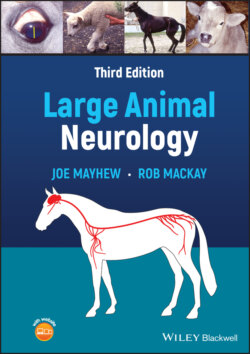Читать книгу Large Animal Neurology - Joe Mayhew - Страница 38
Trigeminal nerve—CN V
ОглавлениеThis large, well‐protected cranial nerve contains motor nerve fibers that innervate the muscles of mastication in the mandibular branch, as well as sensory nerve fibers from most parts of the head in mandibular, maxillary, and ophthalmic branches.
The total loss of motor function of the mandibular nerve bilaterally results in a relaxed, flaccid, and lowered jaw and an inability to chew; it is quite rarely seen, but occurs in large animals. The tongue protrudes because it drops forward in the mouth. Drooling results because of the lack of jaw movement. After 1–2 weeks, atrophy of the temporal, masseter, and pterygoid muscles results. Asymmetric lesions cause asymmetric muscle atrophy and a slightly deviated lower jaw without dysphagia that can become prominent with major dental problems due to irregular dental ware.
Normal horses frequently have visible asymmetry of the temporalis musculature (Figure 2.3). Most often this would appear to be a difference in the attachment of the origin of the muscle at the dorsal crests of the temporal fossae of the parietal bones and is often associated with marked, asymmetric dental problems with some asymmetry in muscle bulk. Any loss or gain in tissue bulk in, around, or behind one orbit results in asymmetric supraorbital fossae, and this can be used as a barometer for such abnormalities, including modest atrophy of chewing muscles resulting from a trigeminal lesion. Marked, asymmetric dental disease does cause asymmetry to the depth of the supraorbital fossae
Function of the sensory branches of this cranial nerve is tested reflexly and directly by assessing sensation to the head. Movement of the ear, eyelids, and lower lips, in response to blunt stimulation of the face, is mediated via the sensory branches of the trigeminal nerve and the motor branches of the facial nerve. Thus, these reflexes require an intact brainstem and trigeminal CN V sensory and facial CN VII motor nuclei and nerves, but do not require the animal to feel the stimuli. Perception of sensation from the head should be assessed in the distribution of each of the major branches of the trigeminal nerve by observing a behavioral response such as head shaking in response to mild noxious stimuli applied to the facial regions innervated by the mandibular, maxillary, and ophthalmic branches of CN V. The mandibular branch certainly supplies sensory innervation for the major part of the rostral tongue in horses. In most patients, especially stoic or obtunded animals, general cerebral perception of such stimuli may be best assessed from lightly probing the internal nares and particularly the nasal septum. Lesions of the sensory nucleus of the trigeminal nerve in the lateral medulla oblongata can cause hypalgesia and hyporeflexia of the face, without weakness of the muscles of mastication. This may result in feed impacting in the rostral cheek pouch. In distinction to this, and especially in horses, prominent cerebral and thalamic lesions can produce contralateral facial hypalgesia without facial hyporeflexia, being most evident in the nasal septum. This is due to the involvement of the sensory pathways in the rostral brainstem and thalamus or to the parietal, sensory cerebral cortex, while sparing the trigeminal nuclei and reflex pathways in the brainstem.
Detection of nasal hypalgesia in the form of slight asymmetry in the behavioral or avoidance response to a stimulus applied to the nasal septum can take considerable patience and should be confirmed by repeated testing. However, confirmation of this clue, along with the presence of asymmetric menace responses and an asymmetric hopping response in the thoracic limbs, may be the only subtle evidence needed to help confirm the presence of asymmetric forebrain disease.
